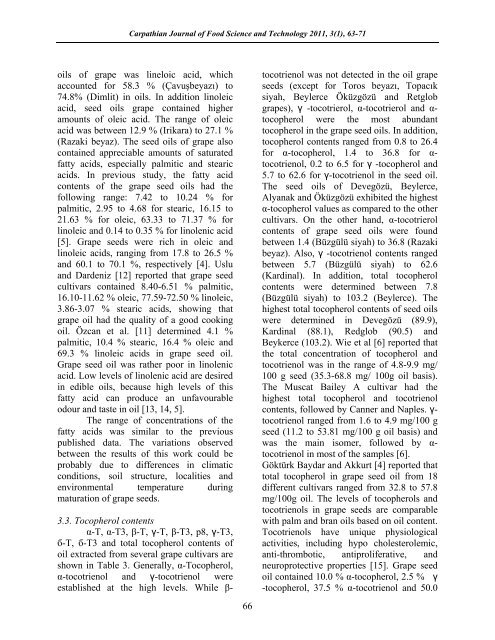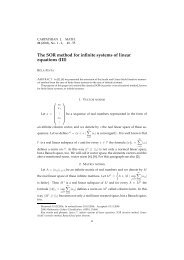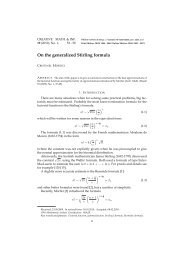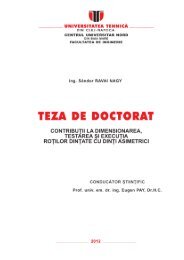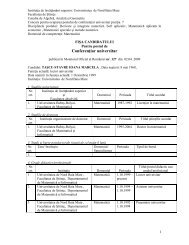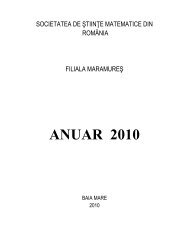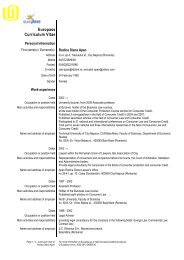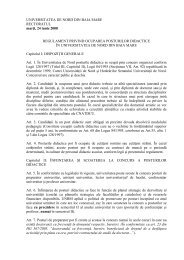Vol 3 (1) 2011 - UBM :: Departamentul de Chimie-Biologie
Vol 3 (1) 2011 - UBM :: Departamentul de Chimie-Biologie
Vol 3 (1) 2011 - UBM :: Departamentul de Chimie-Biologie
You also want an ePaper? Increase the reach of your titles
YUMPU automatically turns print PDFs into web optimized ePapers that Google loves.
Carpathian Journal of Food Science and Technology <strong>2011</strong>, 3(1), 63-71<br />
oils of grape was lineloic acid, which<br />
accounted for 58.3 % (Çavuşbeyazı) to<br />
74.8% (Dimlit) in oils. In addition linoleic<br />
acid, seed oils grape contained higher<br />
amounts of oleic acid. The range of oleic<br />
acid was between 12.9 % (Irikara) to 27.1 %<br />
(Razaki beyaz). The seed oils of grape also<br />
contained appreciable amounts of saturated<br />
fatty acids, especially palmitic and stearic<br />
acids. In previous study, the fatty acid<br />
contents of the grape seed oils had the<br />
following range: 7.42 to 10.24 % for<br />
palmitic, 2.95 to 4.68 for stearic, 16.15 to<br />
21.63 % for oleic, 63.33 to 71.37 % for<br />
linoleic and 0.14 to 0.35 % for linolenic acid<br />
[5]. Grape seeds were rich in oleic and<br />
linoleic acids, ranging from 17.8 to 26.5 %<br />
and 60.1 to 70.1 %, respectively [4]. Uslu<br />
and Dar<strong>de</strong>niz [12] reported that grape seed<br />
cultivars contained 8.40-6.51 % palmitic,<br />
16.10-11.62 % oleic, 77.59-72.50 % linoleic,<br />
3.86-3.07 % stearic acids, showing that<br />
grape oil had the quality of a good cooking<br />
oil. Özcan et al. [11] <strong>de</strong>termined 4.1 %<br />
palmitic, 10.4 % stearic, 16.4 % oleic and<br />
69.3 % linoleic acids in grape seed oil.<br />
Grape seed oil was rather poor in linolenic<br />
acid. Low levels of linolenic acid are <strong>de</strong>sired<br />
in edible oils, because high levels of this<br />
fatty acid can produce an unfavourable<br />
odour and taste in oil [13, 14, 5].<br />
The range of concentrations of the<br />
fatty acids was similar to the previous<br />
published data. The variations observed<br />
between the results of this work could be<br />
probably due to differences in climatic<br />
conditions, soil structure, localities and<br />
environmental temperature during<br />
maturation of grape seeds.<br />
3.3. Tocopherol contents<br />
α-T, α-T3, β-T, γ-T, β-T3, p8, γ-T3,<br />
б-T, б-T3 and total tocopherol contents of<br />
oil extracted from several grape cultivars are<br />
shown in Table 3. Generally, α-Tocopherol,<br />
α-tocotrienol and γ-tocotrienol were<br />
established at the high levels. While β-<br />
66<br />
tocotrienol was not <strong>de</strong>tected in the oil grape<br />
seeds (except for Toros beyazı, Topacık<br />
siyah, Beylerce Öküzgözü and Retglob<br />
grapes), γ -tocotrierol, α-tocotrierol and α-<br />
tocopherol were the most abundant<br />
tocopherol in the grape seed oils. In addition,<br />
tocopherol contents ranged from 0.8 to 26.4<br />
for α-tocopherol, 1.4 to 36.8 for α-<br />
tocotrienol, 0.2 to 6.5 for γ -tocopherol and<br />
5.7 to 62.6 for γ-tocotrienol in the seed oil.<br />
The seed oils of Devegözü, Beylerce,<br />
Alyanak and Öküzgözü exhibited the highest<br />
α-tocopherol values as compared to the other<br />
cultivars. On the other hand, α-tocotrierol<br />
contents of grape seed oils were found<br />
between 1.4 (Büzgülü siyah) to 36.8 (Razaki<br />
beyaz). Also, γ -tocotrienol contents ranged<br />
between 5.7 (Büzgülü siyah) to 62.6<br />
(Kardinal). In addition, total tocopherol<br />
contents were <strong>de</strong>termined between 7.8<br />
(Büzgülü siyah) to 103.2 (Beylerce). The<br />
highest total tocopherol contents of seed oils<br />
were <strong>de</strong>termined in Devegözü (89.9),<br />
Kardinal (88.1), Redglob (90.5) and<br />
Beykerce (103.2). Wie et al [6] reported that<br />
the total concentration of tocopherol and<br />
tocotrienol was in the range of 4.8-9.9 mg/<br />
100 g seed (35.3-68.8 mg/ 100g oil basis).<br />
The Muscat Bailey A cultivar had the<br />
highest total tocopherol and tocotrienol<br />
contents, followed by Canner and Naples. γ-<br />
tocotrienol ranged from 1.6 to 4.9 mg/100 g<br />
seed (11.2 to 53.81 mg/100 g oil basis) and<br />
was the main isomer, followed by α-<br />
tocotrienol in most of the samples [6].<br />
Göktürk Baydar and Akkurt [4] reported that<br />
total tocopherol in grape seed oil from 18<br />
different cultivars ranged from 32.8 to 57.8<br />
mg/100g oil. The levels of tocopherols and<br />
tocotrienols in grape seeds are comparable<br />
with palm and bran oils based on oil content.<br />
Tocotrienols have unique physiological<br />
activities, including hypo cholesterolemic,<br />
anti-thrombotic, antiproliferative, and<br />
neuroprotective properties [15]. Grape seed<br />
oil contained 10.0 % α-tocopherol, 2.5 % γ<br />
-tocopherol, 37.5 % α-tocotrienol and 50.0


